Papers by Himanshu Mittal
Terrestrial, Atmospheric and Oceanic Sciences, Nov 30, 2023
Natural Hazards, Nov 30, 2021
Lecture notes in civil engineering, 2023
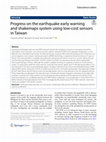
Geoscience Letters, Nov 2, 2022
Building an earthquake early warning (EEW) network requires the installation of seismic instrumen... more Building an earthquake early warning (EEW) network requires the installation of seismic instruments around the seismogenic zone. Using low-cost sensors to build a seismic network for EEW and to generate shakemaps is a costeffective way in the field of seismology. The National Taiwan University (NTU) network employing 762 P-Alert low-cost sensors based on micro-electro-mechanical systems (MEMS) technology is operational for almost the last 10 years in Taiwan. This instrumentation is capable of recording the strong ground motions of up to ± 2 g and is dense enough to record the near-field ground motion. The NTU system has shown its importance during various earthquakes that caused damage in Taiwan. Although the system is capable of acting as a regional as well as an onsite warning system, it is particularly useful for onsite warning. Using real-time seismic signals, each P-Alert device provided a 2-8 s warning time for the near-source earthquake regions situated in the blind zone of the Central Weather Bureau (CWB) regional EEW system, during the 2016 M w 6.4 Meinong and 2018 M w 6.4 Hualien earthquakes. The shakemaps plotted by the P-Alert dense network help to assess the damage pattern and act as key features in the risk mitigation process. These shakemaps are delivered to the intended users, including the disaster mitigation authorities, for possible relief purposes. Currently, the P-Alert network can provide peak ground acceleration (PGA), peak ground velocity (PGV), spectral acceleration (S a) at different periods, and CWB intensity shakemaps. Using shakemaps, it is found that PGV is a better indicator of damage detection than PGA. Encouraged by the performance of the P-Alert network, more instruments are installed in Asia-Pacific countries.
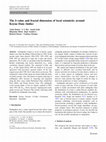
Earthquake Science, Apr 1, 2013
Earthquakes began to occur in Koyna region (India) soon after the filling of Koyna Dam in 1962. I... more Earthquakes began to occur in Koyna region (India) soon after the filling of Koyna Dam in 1962. In the present study, three datasets 1964-1993, 1993-1995, and 1996-1997 are analyzed to study the b-value and fractal dimension. The b-value is calculated using the Gutenberg-Richter relationship and fractal dimension D corr. using correlation integral method. The estimated b-value and D corr. of this region before 1993 are found to be in good agreement with previously reported studies. In the subsequent years after 1995, the b-value shows an increase. The estimated b-values of this region are found within the limits of global average. Also, the pattern of spatial clustering of earthquakes show increase in clustering and migration along the three zones called NorthEast Zone, SouthEast Zone (SEZ), and Warna Seismic Zone. The earthquake events having depth B5 km are largely confined to SEZ. After 1993, the D corr. shows decrease, implying that earthquake activity gets clustered. This seismic clustering could be helpful for earthquake forecasting.
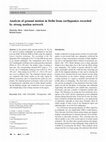
Arabian Journal of Geosciences, Mar 26, 2014
In the present study, ground motions for M w 5.0, 5.5, and 6.0 scenario earthquakes are estimated... more In the present study, ground motions for M w 5.0, 5.5, and 6.0 scenario earthquakes are estimated at one hard rock site Delhi Jal Board (DJB) in Delhi using the empirical Green's function technique. The recordings of the 7th September 2011 earthquake of M w 3.9 at the DJB site are used as an element earthquake. Our computations show that an M w 5.0 earthquake would give rise to peak ground acceleration (PGA) of ∼50 to 250 cm/s 2 , the smaller values occurring at hard sites. The corresponding estimated PGV range is ∼3 to 10 cm/s. M w 5.5 earthquake would give rise to PGA of ∼80 to 350 cm/s 2 , while during M w 6.0 PGA of ∼150 to 670 cm/s 2 may occur at different sites. The estimated response spectra are compared with earlier studies in the same region by different researchers and it is found that the results are comparable. The obtained spectral acceleration values can be used in identifying the vulnerable areas in Delhi, thereby facilitating the planning, design, and construction of new structures and strengthening of the existing structures in the region.
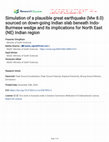
Research Square (Research Square), Dec 29, 2022
The 4th January 2016 Manipur earthquake (Mw 6.7) occurred along the Indo-Burmese wedge and ruptur... more The 4th January 2016 Manipur earthquake (Mw 6.7) occurred along the Indo-Burmese wedge and ruptured towards NW direction causing severe damage to buildings/structures in NorthEast (NE) Indian region. A plausible earthquake (Mw 8.0) is simulated to estimate the ground motions and associated seismic hazard by means of the waveforms of 2016 Manipur earthquake (Mw 6.7) as an element earthquake considering the source in the subduction boundary of the Indo-Burmese wedge at an intermediate depth. The empirical greens function mechanism (EGFM) is adopted to accomplish the better utilization of the observed ground motions of the recorded earthquake as an element earthquake and to achieve the probable ground motions in order to acquire the appropriate path/site effects in the simulated ground motions. The obtained results demonstrate the impact of the comparable rupture directivity pattern in both element as well as the simulated earthquakes. The Peak Ground Acceleration (PGA) in NE India from element and simulated earthquakes vary from 3 cm/sec 2 and 11 cm/sec 2 to 103 cm/sec 2 and 342 cm/sec 2 at epicentral distances of 624 km and 53 km respectively. The high amplitude surface waves due to the interference of seismic waves along with the combined effects of rupture directivity and site ampli cation showcased the highest PGA value at Shillong (SHL). This site is located on Pre-Cambrian rock and situated at an epicentral distance of 214 km from the source zone, which is lying at an intermediate depth that might have propelled the direct seismic waves of higher intensity at a longer distance compared to other sites. The outcome of the present study highlights the signi cance of varied ground motion parameters among the observed sites to the extent of bearing the damage potential of strong ground motions. The related analysis also advocates for the simulated PGA variations and associated duration of the earthquake waveforms exposed on different geological formations that have strong bearings on the seismic risk involved with future probable great earthquake in the study region. Moreover, simulated ground motions of expected plausible disastrous earthquakes on numerous geological formations beneath the various sites have signi cant impacts on designing critical structures/buildings such as schools, hospitals, bridges, dams and nuclear power plants for NE India. Thus, the detailed investigations on ground motion parameters, simulation of ground motion and the in uence of different geological/geomorphological conditions on duration, shape and maximum amplitude of ground motion may be supportive for implementing earthquake risk and mitigation plans in order to assess the seismic hazard of the study region.

Springer eBooks, 2018
Three chief tectonic sub-regions of India (GSI Seismotectonic Atlas of India and its environs. Ko... more Three chief tectonic sub-regions of India (GSI Seismotectonic Atlas of India and its environs. Kolkata: Geological Survey of India, 2000), are the mighty Himalayas along the north, the plains of the Ganges and other rivers, and the peninsula. The Himalayas consist primarily of sediments accumulated over long geological time in the Tethys. A number of efforts are being made to study seismic hazard from earthquakes originating from Himalaya for which networks of seismic instruments are required. Seismic networks provide crucial data to scientists and the public about recent earthquakes, both large and small. By increasing the density of seismic stations, we can rapidly detect and locate earthquakes to provide an advance alert, improve our understanding of earthquake rupture and the associated seismic hazard, and generate, in real-time, state-of health information. This paper outlines the status of strong-motion instrumentation program in India and its future scenario.
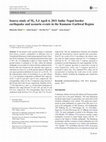
Arabian Journal of Geosciences, Apr 21, 2016
In the present work, ground motion is estimated from future scenario earthquakes at different sit... more In the present work, ground motion is estimated from future scenario earthquakes at different sites in Uttarakhand Himalayas in India using empirical Green's function (EGF) technique. The recorded ground motion from April 4, 2011, M w 5.4 earthquake is taken as a basic element. The ground motion is estimated at 24 sites, where the element earthquake was recorded. It is observed from synthesized time histories that sites located near the epicenter may expect accelerations in excess of 1 g. In the present analysis, Dharchula can expect ground accelerations in excess of 1 g. For M w 7.0, the expected peak values of acceleration (A max) and velocity (V max) on horizontal components at different sites range between 11 and 912 gal and 5 and 52 cm/s, respectively. The corresponding values for the Z component range between 8 and 228 gal, and 3 and 14 cm/s, respectively. Similarly, for M w 7.5, the expected A max and V max on horizontal components at different sites range between 25 and 1281 gal and 25 and 102 cm/s, respectively. The corresponding values for the Z component range between 14 to 474 gal, and 15 to 70 cm/s, respectively. The site amplification functions are estimated using the horizontal-to-vertical spectral ratio procedure. Zone IV (on a scale of II to V according to the seismic zonation map for India) response spectrum for 5 % damping is deficient for M w 7.0, while zone V response spectrum is exceeded at several frequencies for same magnitude. For M w 7.5, zone IV response spectrum is conservative (except at some frequencies), while zone V response spectrum is exceeded at many sites. The estimated PGA values can be incorporated in marking the weak areas in the central Himalaya, thereby assisting the designing and construction of new structures.

Natural Hazards, Feb 19, 2016
In present work, seismic hazard from future earthquake is worked out for Delhi region in terms of... more In present work, seismic hazard from future earthquake is worked out for Delhi region in terms of different strong motion parameters such as peak ground acceleration (PGA), characteristics frequency and spectral acceleration (Sa). The earthquake of March 5, 2012, is taken as key earthquake for synthesis. Stochastic finite modeling technique based on dynamic corner frequency initially is used to produce and match the ground motion histories where 2012 earthquake was recorded. The matching is attained in terms of PGA, response spectra and duration. Once a good match is found, the ground motion is estimated for higher magnitude earthquakes (i.e., Mw 6.0 and Mw 6.5). Our work demonstrates that a Mw 6.0 magnitude earthquake in proximity of Delhi will deliver PGA estimations of 20-209 gal (1 cm/s 2 = 1 gal), the lower values occurring at hard rock sites like NDI (IMD) and DJB. Similarly Mw 6.5 earthquake may produce PGA values ranging between 30 and 323 gal. Finally seismic hazard in Delhi and surrounding regions is estimated from Mw 6.5 magnitude earthquake in terms of PGA, Sa and predominant period. Our computation specifies that at short period, the small structures toward eastern and northwestern part of Delhi city may be affected by the earthquakes. For a case of 0.5 s period, Sa values are distributed uniformly at all the places in Delhi, indicating that the buildings with five floors or so may be in danger from future higher magnitude earthquakes. The Sa maps acquired in this study can be utilized to survey the seismic danger of the region and identify vulnerably susceptible areas in and around Delhi from future higher magnitude earthquake.

Seismological Research Letters, 2013
The recent spurt in global earthquake activity has enhanced the consciousness about the increasin... more The recent spurt in global earthquake activity has enhanced the consciousness about the increasing vulnerability of large population in the region close to Himalayas and has made significant long‐term social and economic impacts. The observation of strong motion and the investigation of the destruction from these earthquakes provide the disciplines of seismology and earthquake engineering with informative and valuable data, experiences, and lessons and raise a number of important scientific challenges. Himalaya is among the most seismically active regions in the world and has experienced several earthquake disasters during historical times. In the last 50 years, the population of India has doubled and resulted in the very rapid growth of settlements, especially in urban areas. At present, about 50 million people in India, living in the Himalayan region and the adjoining plains, are at risk from earthquakes. During the last 200 years, the Indian peninsula has experienced several great earthquakes with a magnitude above 8.0, namely, the Kutch, Gujarat earthquake (1819); the Assam earthquake (1897); the Kangra earthquake (1905); the Bihar–Nepal earthquake (1934); and the Assam earthquake (1950). Most of the parts of the Himalayas comprising North India and Northeastern India are mapped as either seismic zone IV or V in the seismic zonation map of India (on a scale of II–IV). Two of the recent significant earthquakes in North India are the Uttarkashi earthquake of 1991 ( M w 6.8) and the Chamoli earthquake of 1999 ( M w 6.5). Despite being one of the most seismically active regions of the world, the strong‐motion data set in India is, in general, very sparse. For this reason, the seismic hazard in India, until now, has been estimated using either the intensity data or attenuation relations derived for other regions (e.g., Khattri et al. , 1984; Krishna, 1992). Therefore, in the absence of adequate …
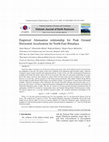
Vietnam Journal of Earth sciences, Feb 15, 2017
NorthEast India is located in one of the most seismic prone areas of the world. India has faced s... more NorthEast India is located in one of the most seismic prone areas of the world. India has faced several devastating earthquakes in the past. The largest of these have originated in the Himalayan plate boundary region, which has remained a region of great scientific and engineering interest. In spite of this, very little seismological information is available about NorthEast India, which is the focus for present study. Only few attenuation relationships are available for this region, which are most valuable in a region where too much strong motion recordings are not available. However in recent time, with the inception of 300 strong motion instruments under Indian National Strong Motion Network deployed under Mission Mode project (Government of India), a good quality of strong motion data became available. Taking the advantage of data collected by this network and earlier analogue strong motion arrays, an endeavor has been made to develop an empirical attenuation relationship for peak horizontal ground accelerations for NorthEast Himalayan region in India. The data set consists of 216 peak ground horizontal accelerations from 24 earthquakes (4.0≤M≤6.8) recorded by strong-motion arrays and National Strong Motion Network project in India. The present analysis uses a two-step stratified regression model. The estimated attenuation relationship for the region is log 1.497 0.3882 1.19 .
Natural Hazards, Sep 9, 2014
In this work, an attempt has been made to simulate strong ground motion of M w 5.4 earthquake in ... more In this work, an attempt has been made to simulate strong ground motion of M w 5.4 earthquake in Kumaun region of Uttarakhand. The simulation is based on modified stochastic finite modeling technique with dynamic corner frequency (Motazedian and Atkinson in Bull Seismol Soc Am 95:995-1010, 2005). Ground motion is simulated for 24 sites, where a magnitude 5.4 earthquake was recorded. Synthesized ground motion is found in close agreement with recorded ones, when compared in terms of main characteristics such as peak ground acceleration (PGA), Fourier spectra, response spectra and duration. Decay of PGA values with distance is almost same as that of observed ones. Successful modeling of present earthquake gives the confidence to understand and quantify seismic hazard of different parts of Uttarakhand from earthquakes of different magnitudes.
Quaternary Science Advances

Natural Hazards, 2020
Delhi, National Capital Region (NCR) of India, falls in the seismic Zone IV (Zone factor 0.24) on... more Delhi, National Capital Region (NCR) of India, falls in the seismic Zone IV (Zone factor 0.24) on the seismic zoning map prepared by the Bureau of Indian Standards (BIS), and this region may experience devastating intensities in case of plausible moderate to the major earthquake in the vicinity. The strategic geological, geomorphological, and geographic characteristics make this seat of administrative power more vulnerable toward the earthquake disaster right from the ancient periods. Therefore, we study the impact of the M 6.0 earthquake sourced at Sohna fault in the neighborhood of the capital region by generating synthetic accelerograms through semiempirical envelop technique. The observed accelerograms of November 25, 2007 (M w 4.7) earthquake have been modeled to utilize the reliability of the semiempirical approach. To analyze the actual scenario, the ground motions at the surface have been generated after the incorporation of the site effects because different soil conditions of NCR fascinate different degrees of damage in case of a destructive earthquake. As a result, the obtained peak ground acceleration (PGA) varies between 100 and 600 cm/s 2 , and some of the sites exhibit even higher PGA values being situated on the sediments of river-oriented plain areas and proximity of the source. The spatial distribution of estimated values of PGA and spectral accelerations at different periods show that sites in NCR like Delhi (600 cm/s 2), Sonipat (633 cm/s 2), Gurgaon (461 cm/s 2), and Faridabad (300 cm/s 2) exhibit high to severe seismic hazard in case of M 6.0 at Sohna fault and it is suggested that a population of about 4.78 million along with the infrastructure of this region is exposed to high risk. The estimated seismic exposure of the population is important to utilize the resources properly before the destructive earthquake incidence. The hazard maps for PGA and different structural periods in the NCR region reveal the level of seismic hazard and risk of the study region. These hazard maps are very helpful for administrators, stakeholders, and civil engineers to construct earthquake-resistant structures to minimize the risk generated by the future impending earthquakes. The exponential growth of the buildings, industries, businesses, etc., attracts the attention of urban area planners because of high seismic risk due to the damaging earthquakes, and its severity must be understood to save the life and property to mitigate the natural disaster like an earthquake by proper disaster mitigation plans, especially in the metropolitan cities like Delhi NCR.
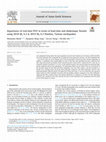
Journal of Asian Earth Sciences, 2021
Two earthquakes having almost the same magnitude occurred in the Hualien area of Taiwan in 2018 a... more Two earthquakes having almost the same magnitude occurred in the Hualien area of Taiwan in 2018 and 2019. The 2018 earthquake had a magnitude M L 6.2 produced severe destruction; however, the 2019 earthquake (M L = 6.3) did not cause any severe damage. The P-Alert Strong Motion Network provides real-time shakemaps, in addition, to earthquake early warning (EEW) in terms of lead-time. Each instrument provides a different leadtime using peak ground acceleration (PGA) and peak ground velocity (PGV). During both the events, the instruments reported a lead-time of 1.5 to 8.0 s in the epicentral region. This network system also generated highquality shakemaps during both earthquakes. The shakemaps showed that the higher PGAs are concentrated in the epicentral region for the 2018 and 2019 earthquakes. The lower PGA contour (≥25 Gal) extended to a broader area, including Taipei, during the 2019 earthquake compared to the 2018 earthquake. However, PGV shakemaps display a different pattern. The higher PGV values (more than 17 cm/s) are observed in the epicentral region during the 2018 earthquake (locations suffering building collapse) compared to the 2019 earthquake, suggesting that PGV correlates better with damage distribution as compared to the PGA. The PGV shakemap, currently only available for the P-Alert network, provides crucial information that complements the PGA issued by the official agency in Taiwan.
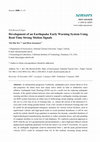
Arabian Journal of Geosciences, Jul 1, 2020
As urbanization progresses worldwide, earthquakes pose serious threat to lives and properties for... more As urbanization progresses worldwide, earthquakes pose serious threat to lives and properties for urban areas near major active faults on land or subduction zones offshore. Earthquake Early Warning (EEW) can be a useful tool for reducing earthquake hazards, if the spatial relation between cities and earthquake sources is favorable for such warning and their citizens are properly trained to respond to earthquake warning messages. An EEW system forewarns an urban area of forthcoming strong shaking, normally with a few sec to a few tens of sec of warning time, i.e., before the arrival of the destructive Swave part of the strong ground motion. Even a few second of advanced warning time will be useful for pre-programmed emergency measures for various critical facilities, such as rapid-transit vehicles and high-speed trains to avoid potential derailment; it will be also useful for orderly shutoff of gas pipelines to minimize fire hazards, controlled shutdown of high-technological manufacturing operations to reduce potential losses, and safeguarding of computer facilities to avoid loss of vital databases. We explored a practical approach to EEW with the use of a ground-motion period parameter τ c and a high-pass filtered vertical displacement amplitude parameter Pd from the initial 3 sec of the P waveforms. At a given site, an earthquake magnitude could be determined from τ c and the peak ground-motion velocity (PGV) could be estimated from Pd. In this method, incoming strong motion
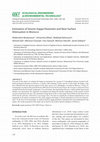
Ecological Engineering & Environmental Technology
The goal of this study is to estimate the kappa (κ) parameter for a group of 12 broadband station... more The goal of this study is to estimate the kappa (κ) parameter for a group of 12 broadband stations, located in different geological structures in Morocco, a country with moderate seismic activity. In this study, the kappa, κ has been obtained from the spectral analysis of the shear waves of 42 earthquakes, recorded in Morocco. Using 321 seismograms recorded in the period between 2009 and 2012 by the Picasso Project, the average κ-values have been computed from the horizontal components. For each station, the relationship between κ values and the hypocentral distance was determined. We separately investigated and studied the distance dependence of the stations located on soft soil and hard rock sites. The estimated average factor of the κ value ranges from 0.0682 for the hard sites to 0.0763 for the soft sites, with 0.072 as an average value. The lack of a significant correlation found between κ and magnitude at all stations considered in this study suggests that kappa is mainly dependent on local site characteristics. To the best of our knowledge, no studies related to kappa parameter estimation have been published for this region. The results generated in this study can be used for the seismic hazard evaluation of Morocco.

Journal of the Geological Society of India, 2021
The earthquake early warning (EEW) system in Taiwan is the outcome of rigorous research work carr... more The earthquake early warning (EEW) system in Taiwan is the outcome of rigorous research work carried out at various levels after the occurrence of the 1986 Hualien earthquake that caused destruction. After more than 25 years of development, three different EEW systems exist in Taiwan. Currently, the nation wide regional EEW system is operated by the Central Weather Bureau (CWB), whereas, a hybrid (regional & onsite) system based on Micro-Electro-Mechanical System sensors is run by National Taiwan University (NTU). The third EEW (onsite system) is run by the National Center for Research on Earthquake Engineering (NCREE). Both CWB and NTU systems are capable of reporting the EEW warnings within 20 seconds of earthquake occurrence. The CWB system is incharge of providing earthquake alerts in Taiwan via text message through mobile phone, TV, and directly broadcasting system to schools and is providing earthquake alarms to the general public since 2016. During recently damaging earthquakes in Taiwan, the NTU system provided 2–8 seconds onsite warning (lead time) in the blind zone around the epicenter. The NTU system also can generate near real-time shake maps for rapid response purposes. The NCREE system consists of about 98 stations and can provide several seconds lead time in the area near the epicenter. The NCREE system also can receive CWB regional EEW messages for warning the regions away from the epicenter. Individually every system has its advantage, however, the hybrid approach will be one of the future systems for real operation.











Uploads
Papers by Himanshu Mittal